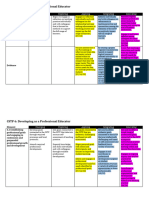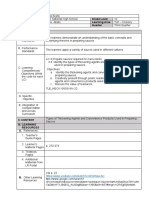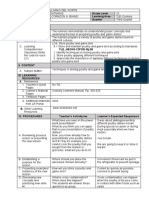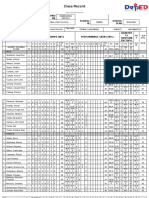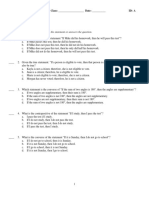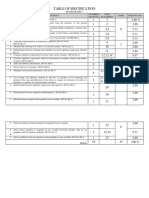Professional Documents
Culture Documents
Instructional Decision Making
Instructional Decision Making
Uploaded by
Fatima YZOriginal Description:
Original Title
Copyright
Available Formats
Share this document
Did you find this document useful?
Is this content inappropriate?
Report this DocumentCopyright:
Available Formats
Instructional Decision Making
Instructional Decision Making
Uploaded by
Fatima YZCopyright:
Available Formats
Differentiation
Through
Instructional
Decision Making
Differentiation is a
process teachers use to
enhance a student’s
learning by improving the
match between a
learner’s unique
characteristics and the
various components of the
curriculum, instruction,
and assessment.
Summer 2005 ASCD Differentiation
Conference
This information about Instructional Decision Making is provided by
Heartland AEA 11. Instructional Decision Making is supported by the Iowa
Department of Education and Heartland Area Education Agency.
Models or Processes with Similar Characteristics to
Instructional Decision Making is… Instructional Decision Making
Instructional Decision Making is a systematic Idea Common What do Source
process of using student achievement and other data Labels people
to guide instructional decisions. It is supported say?
through the Iowa Department of Education’s Instructional IDM Iowa
Instructional Decision Making (IDM) initiative. IDM is Decision Department of
An ongoing process of using student achievement and other
Making Education
designed to improve the learning of all students. IDM
is the terminology used by the Department of Response to RTI IDEA
Education and the stakeholders designing and Intervention
supporting the initiative aimed at increasing the use
data to guide instructional decisions.
of this systematic process in Iowa schools. There are Schoolwide SWISS Kameenui &
other terms used by individuals and groups to Model (School Wide Simmons
describe processes that contain the same essential Instructional
Support
elements as IDM. These terms, initiatives, or models System)
are not in opposition with IDM. Indeed, they support
one another. Schools may want to use their own Schoolwide PBS (Positive Sugai and
terminology or labels as the process is incorporated Behavior Behavior Horner
at the local level. Supports Supports)
Three-Tiered 3-Tier Model Sharon
Instructional Decision Making supports a unified Intervention Vaughn
schoolwide or districtwide system of assessment, Model (Texas)
curriculum, and instruction addressing the needs of Standard Standard Doug Fuchs
high, average, and low-performing learners. The Treatment Treatment
process of using data systematically to make Protocol
instructional decisions provides a framework for Mental Health Tertiary Adleman and
aligning resources to meet the needs of groups of Services Model of Taylor
students as well as individual students. Service
Gifted Services Levels of Treffinger
Instructional Decision Making is not… Service
Approach
an instructional program. It is a project to assist
schools to establish a framework to make decisions
about instructional needs based on student
performance data.
intended to promote or encourage placement into
programs, rather it is to promote the match between
instruction and student need.
intended to focus only on students who are below
expected levels of proficiency. There are gifted
students who require significant differentiation or
acceleration.
Something that can be implemented independently.
Instead, it is a cooperative effort of teachers,
administrators and support staff.
Key Features of Instructional Decision Making
Instructional Decision Making and Continuous
Improvement Instructional Decision Making focuses at the
student level.
Plans are developed to ensure appropriate
Assess ing instruction for all students even at the
Needs individual level if needed.
The structure allows immediate feedback
regarding effects.
Eva lu a t in g
Pla n n in g
Contin u o u s The process is repeated frequently
Im pr ov e ment throughout the school year.
Data are used to match students with similar
needs to resources and strategies to meet
Impl e ment ing those needs.
It is not just all children...but each child!
The process of using data to match instruction to
student needs uses a continuous improvement model
of needs assessment, planning, implementation, and
evaluation. These same four stages are present in
the Iowa Professional Development Model, the Iowa
Support System to Support Schools in Need of
Assistance, and the Heartland Problem Solving
model.
Continuous improvement is the process in which
all schools engage to plan and improve systems.
Continuous improvement efforts should include Benefits of Instructional Decision Making
all students (those who struggle and those who
achieve at high levels). Instructional Decision Making will help
The Iowa Professional Development Model educators to know immediately, “Is what we
focuses on improving student achievement. To are doing working?”
do this, educators must have the skills, Schools will know which children need
knowledge, behaviors, attitudes, and aspirations something different.
needed to provide quality instruction. Educators will be able to intervene early.
The process used when a school is identified as Schools will make the most efficient use of
SINA follows the same four steps, but is targeted existing resources by matching them to
toward a particular area of need and includes student needs. i.e. gifted, Title I, at-risk,
specific requirements. special education, ESL. (Different kinds of
In Heartland, the Problem Solving Model has data may need to be collected based on
been used to identify student needs and students’ unique needs.)
implement instructional interventions. It has been IDM will assist to streamline and integrate
utilized within a system of teacher and parent the use of data.
referral. Staff will be empowered to make effective
instructional decisions for all students.
Instructional Decision Making uses the same four- If data are continually collected, and if
step process as each of these, with the focus on decisions are based on the data, student
meeting the instructional needs of all students. achievement will improve.
Foundational Principles Parents are vital members of the team to
support students.
There is shared responsibility for student Administrators and teacher leadership teams
achievement across the entire school are vital in the instructional leadership and
community. data-based decision making of a district and
All students are part of the general education school.
system. Teachers have adequate tools, strategies,
The best way to address student-learning support, and resources to meet the needs of
needs is to be proactive. all students.
Differentiated instruction is an essential part Quality professional development is essential
of an instructional program. to support implementation of a systemic
Accurate reliable assessment data are effort to support IDM.
essential to determine the instructional A variety of research-based practices will be
abilities of all students. needed to address the needs of learners (not
Instructional decisions are based on multiple one size fits all).
sources of data. Each school has a unique culture, and a
The effectiveness of instruction is routinely unique set of resources and needs requiring
monitored; ongoing formative data are used a tailored system of decision-making.
to indicate when changes in instruction are Individuals with skills in data-based decision
needed. making will be needed to support the
process.
Essential Steps or Components Although students are grouped and
individual instructional needs are met,
As stated earlier, Instructional Decision Making is data must also be used to consider if
based on a continuous improvement cycle. This improvement to the core instructional
cycle is repeated throughout the school year program is needed.
attending to the needs of all students including
those in general education, special education, at-
risk programming, English Language Learners
(ELL) and gifted and talented students. The
specifics of implementation are dependent on the
school, but there are some basic steps or
components that will be present in every site.
1. A process (based on student performance data) will
be utilized to identify those students who may be in
need of differentiated instruction and what their
specific instruction needs might be.
2. Students are grouped for instruction with some
students needing more intensive instruction than
others.
3. The progress of those students receiving
differentiated instruction is monitored as well as the
implementation of that instruction. Changes are
made as needed.
4. The process is repeated (usually three times per
year).
Instruction
Three levels of instruction are typically needed.
Core Instruction: Comprehensive instruction
provided in general education for all students. All
students must have access to core instruction.*
Supplemental Instruction: Instruction provided
to some students that is differentiated to meet
their needs. This instruction may look very
different based upon student need. Some
students may need preteaching or reteaching.
Intensive Instruction: Instruction provided to a
few students who need significant differentiation
and greater intensity in their instruction.
*Participation in core instruction at the same level as
same age peers may not be appropriate for some
students.
Assessments
Screening Assessments are linked to district
standards and benchmarks and used to identify What will it take for an IDM initiative to be
students at-risk of not meeting expectations or successful?
those who are exceeding expectations. (Screening
in some situations needs to occur at least 3 times The following components of effective
per year.) continuous improvement will be necessary
for success with Instructional Decision
Diagnostic assessment processes are used to Making.
specify the individual needs of students
(Administered when indicated by data.) 1. Focus on Instruction
2. Continuous Staff Development
Progress monitoring and formative 3. Continuous Assessment of Student
assessments are used to determine the effects of Performance and Implementation
instruction and to make instructional changes 4. Sustained Effort
when needed. (Monthly, biweekly, or weekly) 5. Technical Assistance
6. Willingness to Lead, (Administrative
Summative assessments are large scale support and teacher leadership)
assessments linked to statewide learning 7. Policy Support,
outcomes. In Iowa the measures primarily used 8. Cross Role Learning (Requiring
are ITBS and ITED. Collaboration)
9. Time
(From Every Child Reads)
Frequently Asked Questions
1. Is this initiative required?
No. This initiative is supported by the state and by Heartland AEA 11, but is not mandated.
2. How does this project fit with other initiatives?
IDM is a systematic decision-making framework for supporting effective practices to meet the needs of all students. It is a way of
looking at and analyzing student achievement and other data that supports other initiatives within a system. What IDM adds to
other initiatives is a focus on the use of data to determine that each student’s educational needs are being met. Defining a
comprehensive system for using data can streamline and increase the efficiency and effectiveness of existing building practices.
For example, the CSIP and IPDM processes involve collecting and analyzing student data to set goals, develop a plan, and
determine content for professional development. IDM ensures that we are examining data from each student to meet the needs of
each and every learner and continues to provide specific student data to assist with formative and summative evaluation.
Effectively using CSIP, IPDM, and IDM together will help more students be successful.
3. How does Instructional Decision Making support differentiation of instruction?
This process directly supports the notion of differentiation. While few argue the need to differentiate, the decisions about what and
how to differentiate for each student are more difficult. Content, process, context, and student characteristics should be
considered as decisions are made about the individual student’s needs for differentiation. These considerations should be data
based. Differentiating core instruction, however, will not address the needs of individual learners who require skill-building
instruction or advanced learning. Likewise, providing supplemental, skill-building instruction for short periods does not mean that
students will be able to handle the large group instruction provided throughout the day. IDM looks at all parts of the curriculum,
ensuring that the core is differentiated and there is differentiated instruction for students who need it.
5. Isn’t this a special education initiative?
No. Instructional Decision Making is focused on the continual challenge of meeting the needs of ALL students. It provides the
framework for creating a seamless process of decision making across ALL levels of student instructional need. A seamless
process emphasizes shared responsibility for the students within a school and creates a seamless response to the students
instructional needs using various resources, programs, and services developed for students of similar instruction needs.
Identification for such services as ESL, gifted and talented, Title I, special education, and other targeted services and programs
can be enhanced using this more systematic process.
6. This sounds like problem solving. Don’t we already do this?
IDM applies problem solving practices in a systemic manner. The intent of IDM is to be proactive in response to instructional
needs rather than reactive. It uses a screening process to identify low-and high-performing students at risk for not having their
needs met, and provides intervention at the earliest possible moment.
7. Isn’t this a deficit model?
No, the IDM is inclusive of all students. Students whose performance is exceeding expectations have unique needs that should
be addressed through significant differentiation or acceleration. The assessments used to identify these students may vary, but
the framework of using data to guide instructional decisions applies to all students.
8. Will schools be required to use certain assessments and instructional programs?
No. Each school will determine which assessments they will use and what instructional practices will be implemented to respond
to student needs.
9. Isn’t it more important that we improve our core instruction. (Won’t this take away from those efforts?)
Improvements to core instruction are essential and continuous. At the same time core instruction is improving, there will be
students with individual needs. Doing both is our responsibility and it is the only way we can truly serve all students.
Heartland Area Education Agency 11 does not discriminate based on gender, race, national/ethnic origin, creed, age, marital status, sexual orientation, or
disability. Direct inquiries to the Affirmative Action Coordinator, 6500 Corporate Dr., Johnston, IA 50131-1603, or Director, Office of Civil Rights, Chicago,
IL 60606-7204.
You might also like
- Bda Lesson PlanDocument4 pagesBda Lesson Planapi-338886620No ratings yet
- ABA in ClassroomDocument4 pagesABA in ClassroomSonia AssuncaoNo ratings yet
- Leadership Team ResponsibilitesDocument2 pagesLeadership Team Responsibilitesapi-286739810No ratings yet
- MRCPI Part II Obstetrics & GynecologyDocument4 pagesMRCPI Part II Obstetrics & GynecologyNitasha Maqsood25% (4)
- Routes To RICS MembershipDocument4 pagesRoutes To RICS MembershipMithila HandagamaNo ratings yet
- MSDF StudentRoles FINAL 26jan2018v1Document3 pagesMSDF StudentRoles FINAL 26jan2018v1Mysweet PenNo ratings yet
- Classroom Walkthrough Development ChecklistDocument13 pagesClassroom Walkthrough Development Checklistdarkkitten76100% (1)
- Cheilari Coniam 2020 Preparing For Teaching Exam Classes in The New School YearDocument3 pagesCheilari Coniam 2020 Preparing For Teaching Exam Classes in The New School YearGLYKERIA MANGELANo ratings yet
- PosterDocument1 pagePosterapi-743431971No ratings yet
- Chapter 4 COMPONENTS OF SPECIAL AND INCLUSIVE EDUCATIONDocument25 pagesChapter 4 COMPONENTS OF SPECIAL AND INCLUSIVE EDUCATIONYugi IshitariNo ratings yet
- Developmental Math Research Symposium PatcarleyDocument1 pageDevelopmental Math Research Symposium Patcarleyapi-373389174No ratings yet
- Name: Nayab Amjad ROLL NO: MCF1900609 Program: Ma Education (Morning)Document27 pagesName: Nayab Amjad ROLL NO: MCF1900609 Program: Ma Education (Morning)Nayab Amjad Nayab AmjadNo ratings yet
- 5 Formative Strategies To Improve Student Learning From Dylan Wiliam and NWEADocument1 page5 Formative Strategies To Improve Student Learning From Dylan Wiliam and NWEAKelly WangNo ratings yet
- 2020 Academic Plan School Year 2020.21Document24 pages2020 Academic Plan School Year 2020.21Sarah KhanNo ratings yet
- CSTP 1 Tobias 050524Document10 pagesCSTP 1 Tobias 050524api-678550674No ratings yet
- CSTP 6 Rogosic 4Document9 pagesCSTP 6 Rogosic 4api-566253930No ratings yet
- Effectiveness of Modular Approach in Teaching at University LevelDocument8 pagesEffectiveness of Modular Approach in Teaching at University LevelMarlon Canlas MartinezNo ratings yet
- TestingDocument57 pagesTestingAlex DreierNo ratings yet
- FFT_UDL_Crosswalk_20180514Document29 pagesFFT_UDL_Crosswalk_20180514Eric J PollockNo ratings yet
- 1 - SP10 Teaching IA - 2Document6 pages1 - SP10 Teaching IA - 2maria daniela riveroNo ratings yet
- Group 4 ResearchDocument14 pagesGroup 4 ResearchPamela Jane GarciaNo ratings yet
- Educational Data Mining and Its Role in Determining Factors Affecting Students Academic Performance A Systematic ReviewDocument7 pagesEducational Data Mining and Its Role in Determining Factors Affecting Students Academic Performance A Systematic ReviewShujat Hussain GadiNo ratings yet
- Strat Planning Module 3Document6 pagesStrat Planning Module 3john rexNo ratings yet
- JSTOR Formative Assessment 29 Nov 2021 28 Dec 2021 6 Jan 2022 7 Jan 2022 28 Oct 2023Document7 pagesJSTOR Formative Assessment 29 Nov 2021 28 Dec 2021 6 Jan 2022 7 Jan 2022 28 Oct 2023Rubina SaffieNo ratings yet
- The Formative Assessment Process in A Comprehensive AssessmentDocument43 pagesThe Formative Assessment Process in A Comprehensive AssessmentТетяна СтрельчукNo ratings yet
- cstp1 Doss 4Document13 pagescstp1 Doss 4api-572651121No ratings yet
- Individual Development Plan: Action Plan (Recommended Developmental Intervention) Timeline Resources NeededDocument4 pagesIndividual Development Plan: Action Plan (Recommended Developmental Intervention) Timeline Resources NeededMichaelAbdonDomingoFavo100% (2)
- Work Plan For The Professional Career in Computing and InformaticsDocument5 pagesWork Plan For The Professional Career in Computing and InformaticsScribdTranslationsNo ratings yet
- Technology Students of Using Online LearningDocument3 pagesTechnology Students of Using Online LearningMaria Sofia AngoluanNo ratings yet
- Lesson 2 Principles of AssessmentDocument15 pagesLesson 2 Principles of AssessmentLysha FleurNo ratings yet
- Practical Task 2 Santiago PérezDocument4 pagesPractical Task 2 Santiago PérezSantiago PérezNo ratings yet
- Module 1 Nature and Characteristics of Action ResearchDocument8 pagesModule 1 Nature and Characteristics of Action ResearchDora ShaneNo ratings yet
- Melendez Coherence Assessment ToolDocument3 pagesMelendez Coherence Assessment Toolapi-683913967No ratings yet
- cstp1 Hayek 04Document8 pagescstp1 Hayek 04api-678417409No ratings yet
- Title MatrixDocument1 pageTitle MatrixCharity AmboyNo ratings yet
- Adaptive Learning & TestingDocument32 pagesAdaptive Learning & TestingEmilio SotoNo ratings yet
- Classroom ManagementDocument1 pageClassroom ManagementMaria Lorena Castro MendozaNo ratings yet
- High Impact Teach StratDocument32 pagesHigh Impact Teach StratAnaly BacalucosNo ratings yet
- Individual Development PlanDocument2 pagesIndividual Development PlanAna Cel MarbebeNo ratings yet
- Sweeneystudent Centered Coaching From A Distance pg.6-7Document3 pagesSweeneystudent Centered Coaching From A Distance pg.6-7tanmandarinNo ratings yet
- Finalized LDM Individual Learning Development PlanDocument5 pagesFinalized LDM Individual Learning Development PlanRIZZA ALMOJUELANo ratings yet
- Practice Tests, Spaced Practice, and Successive Relearning: Tips For Classroom Use and For Guiding Students' LearningDocument7 pagesPractice Tests, Spaced Practice, and Successive Relearning: Tips For Classroom Use and For Guiding Students' LearningCarlaNo ratings yet
- CSTP 1 Shubin-Kosareff 04Document11 pagesCSTP 1 Shubin-Kosareff 04api-700901076No ratings yet
- A Review Study of The Effectiveness of Computer-Assisted Instruction in Teaching and LearningDocument17 pagesA Review Study of The Effectiveness of Computer-Assisted Instruction in Teaching and LearningkgarciaNo ratings yet
- Action Research Integrating ICT in EducationDocument30 pagesAction Research Integrating ICT in EducationRichard BañezNo ratings yet
- NCCD Reflection Tool PDFDocument9 pagesNCCD Reflection Tool PDFbjamgibsonNo ratings yet
- Individual Development PlanDocument3 pagesIndividual Development PlanMARLON SICAT100% (1)
- An Integrated Framework For Assessing orDocument6 pagesAn Integrated Framework For Assessing orMinh right here Not thereNo ratings yet
- High Impact Teaching PracticesDocument32 pagesHigh Impact Teaching PracticessunnylamyatNo ratings yet
- Researchtopic ProposalDocument7 pagesResearchtopic ProposalAlly MarinoNo ratings yet
- Individual Development Plan Action Plan (Recommended Developmental Intervention) Timeline Resources NeededDocument3 pagesIndividual Development Plan Action Plan (Recommended Developmental Intervention) Timeline Resources NeededLloydNo ratings yet
- Nomkhosi Nkomo ST10122214 ASME7312 POEDocument4 pagesNomkhosi Nkomo ST10122214 ASME7312 POEMacowza100% (1)
- CSTP 1 Mora 7 14 23Document6 pagesCSTP 1 Mora 7 14 23api-679271053No ratings yet
- Actionplanaism2017 c3 TeachingandlearningDocument3 pagesActionplanaism2017 c3 Teachingandlearningapi-353859154No ratings yet
- Research Paper Education: Dr. M. Parimala Fathima DR - AR.SaravanakumarDocument9 pagesResearch Paper Education: Dr. M. Parimala Fathima DR - AR.SaravanakumarJoan JohnNo ratings yet
- Formative and Summative AssessmentDocument8 pagesFormative and Summative AssessmentMumtahina Supti100% (1)
- CSTP 6 Ramos 050324Document13 pagesCSTP 6 Ramos 050324api-679112611No ratings yet
- Area/Specific Objectives Activities People Duration BudgetDocument3 pagesArea/Specific Objectives Activities People Duration BudgetMercedes A. MacarandangNo ratings yet
- Teachers Views On Classroom Infrastructure FaciliDocument4 pagesTeachers Views On Classroom Infrastructure FaciliAmirah AdilahNo ratings yet
- Social and Emotional Aspects of Learning (SEAL) : School Self-Review Primary and SecondaryDocument12 pagesSocial and Emotional Aspects of Learning (SEAL) : School Self-Review Primary and SecondaryGertrude Ndukwe Alex-nworieNo ratings yet
- Data Collection Procedures AssignmentDocument3 pagesData Collection Procedures AssignmentYarinnys Soto ArroyoNo ratings yet
- Is It Working in Your Middle School?: A Personalized System to Monitor Progress of InitiativesFrom EverandIs It Working in Your Middle School?: A Personalized System to Monitor Progress of InitiativesNo ratings yet
- Systemic School Improvement Interventions in South Africa: Some Practical Lessons from Development PractionersFrom EverandSystemic School Improvement Interventions in South Africa: Some Practical Lessons from Development PractionersNo ratings yet
- Cecelia A. Abalo TLE-Cookery Third QuarterDocument9 pagesCecelia A. Abalo TLE-Cookery Third QuarterFatima YZNo ratings yet
- MATH 10 DLL WEEK 5 Jul. 1-4, 2019Document4 pagesMATH 10 DLL WEEK 5 Jul. 1-4, 2019Fatima YZ100% (1)
- MATH 10 DLL WEEK 3 Jun. 17-20, 2019Document3 pagesMATH 10 DLL WEEK 3 Jun. 17-20, 2019Fatima YZNo ratings yet
- 10 TLE-Cookery Third: Division School Grade Level Teacher Learning Area Time & Dates Quarter I. ObjectivesDocument9 pages10 TLE-Cookery Third: Division School Grade Level Teacher Learning Area Time & Dates Quarter I. ObjectivesFatima YZNo ratings yet
- Division School Grade Level Teacher Learning Area Time & Dates Quarter I. ObjectivesDocument10 pagesDivision School Grade Level Teacher Learning Area Time & Dates Quarter I. ObjectivesFatima YZNo ratings yet
- Division School Grade Level Teacher Learning Area Time & Dates Quarter I. ObjectivesDocument4 pagesDivision School Grade Level Teacher Learning Area Time & Dates Quarter I. ObjectivesFatima YZNo ratings yet
- 3 1-CookeryDocument9 pages3 1-CookeryFatima YZNo ratings yet
- Class Record: Region Divisi ON School Name School ID School YearDocument3 pagesClass Record: Region Divisi ON School Name School ID School YearFatima YZNo ratings yet
- Division School Grade Level Teacher Learning Area Time & Dates Quarter I. ObjectivesDocument5 pagesDivision School Grade Level Teacher Learning Area Time & Dates Quarter I. ObjectivesFatima YZNo ratings yet
- On Aristotle, Entelechy, and Realizing Your Potential: The Entelechy of A SeedDocument9 pagesOn Aristotle, Entelechy, and Realizing Your Potential: The Entelechy of A SeedFatima YZNo ratings yet
- Math Department Least Learned 4thDocument15 pagesMath Department Least Learned 4thFatima YZNo ratings yet
- Conditional Statements Quiz PDFDocument6 pagesConditional Statements Quiz PDFFatima YZNo ratings yet
- 2Q Math G7 TosDocument2 pages2Q Math G7 TosFatima YZNo ratings yet
- 4 Grade Lesson Plan - Fabulous Fibonacci and His Nifty NumbersDocument15 pages4 Grade Lesson Plan - Fabulous Fibonacci and His Nifty NumbersFatima YZNo ratings yet
- FD 03 Midterm Exam - Joshua Jade G. Sumabon, LPTDocument5 pagesFD 03 Midterm Exam - Joshua Jade G. Sumabon, LPTJosh SumabonNo ratings yet
- Introduction To MontessoriDocument11 pagesIntroduction To Montessoribahadoor22i5583No ratings yet
- Exam FeeDocument3 pagesExam FeeMian BialNo ratings yet
- Bannari Amman PDFDocument393 pagesBannari Amman PDFDeepu AntonyNo ratings yet
- DLP Sampling ProcedureDocument7 pagesDLP Sampling ProcedureCristel Anne A. Llamador100% (1)
- UNIT 4 - LESSON 3 - PART 1 - Listening and ReadingDocument5 pagesUNIT 4 - LESSON 3 - PART 1 - Listening and ReadingPhuongNo ratings yet
- Reading Comprehension Scarecrow FriendsDocument2 pagesReading Comprehension Scarecrow Friendsapi-524919792No ratings yet
- Research On The Design Ideas of Exhibition Design From The Perspective of Visual BeautyDocument5 pagesResearch On The Design Ideas of Exhibition Design From The Perspective of Visual BeautynyeinayeeeNo ratings yet
- Classroom Management PortfolioDocument27 pagesClassroom Management Portfolioapi-604059060No ratings yet
- INTERSHIP PPT LectureDocument16 pagesINTERSHIP PPT LectureMohammed AawezNo ratings yet
- Personal Development Lesson 4Document27 pagesPersonal Development Lesson 4Angelica AlmedaNo ratings yet
- Final Research Paper PDFDocument12 pagesFinal Research Paper PDFKely FernandesNo ratings yet
- Community Engagement, Solidarity and Citizenship: First Quarter - Module 6Document17 pagesCommunity Engagement, Solidarity and Citizenship: First Quarter - Module 6ANN LYNN RABULAN70% (10)
- Educ 5312-Research Paper WeeblyDocument4 pagesEduc 5312-Research Paper Weeblyapi-290266366No ratings yet
- Lesson Plan With Accommodations ReflectionDocument2 pagesLesson Plan With Accommodations Reflectionapi-543319841No ratings yet
- Self Undertaking Format PDFDocument1 pageSelf Undertaking Format PDFabhayNo ratings yet
- Assessment PortfolioDocument3 pagesAssessment PortfolioJessica BrummelNo ratings yet
- Kinds EnggDocument8 pagesKinds EnggSumaNo ratings yet
- Professional SummaryDocument2 pagesProfessional SummaryShaju KumarNo ratings yet
- One InsectDocument12 pagesOne Insectvietyini2No ratings yet
- The National Competency-Based Teacher StandardsDocument7 pagesThe National Competency-Based Teacher StandardsJacquelyn MendozaNo ratings yet
- Darling Hammond2019 PDFDocument45 pagesDarling Hammond2019 PDFsantimosNo ratings yet
- Science Lesson Plan 1Document6 pagesScience Lesson Plan 1HamadNo ratings yet
- Education Course Catalog enDocument8 pagesEducation Course Catalog enlipasot781No ratings yet
- College Performance of Als Graduate EditedDocument2 pagesCollege Performance of Als Graduate EditedLaurence Niña X. OrtizNo ratings yet
- Educational Assistant Evaluation ReflectionDocument2 pagesEducational Assistant Evaluation Reflectionapi-256799877No ratings yet
- Lesson Planning & Classroom Management, FinalDocument19 pagesLesson Planning & Classroom Management, FinalKatty MokwakwaNo ratings yet
























































